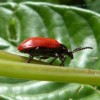Abstract
Around 5% of the plant species deliberately introduced into Florida for crop production and horticultural uses have invaded sensitive aquatic and terrestrial natural areas as well as improved pastures. One of the reasons they become invasive is they lack the natural enemies that limit their reproduction. Biological control reunites these natural enemies (usually arthropods) with their host plants to selectively weaken and suppress the invasive weeds. This 3-page fact sheet was written by J. P. Cuda and J. H. Frank and published by the UF Department of Entomology and Nematology, October 2012.
References
Buckingham, G. R. 1994. Biological control of aquatic weeds, pp. 413 - 480. In: D. Rosen, F. D. Bennett and J. L. Capinera (eds.). Pest management in the subtropics: biological control - a Florida perspective. Intercept, Andover, U.K.
Center, T. D. 1994. Biological control of weeds: waterhyacinth and waterlettuce, pp. 481-521. In: D. Rosen, F. D. Bennett and J. L. Capinera (eds.). Pest management in the subtropics: biological control - a Florida perspective. Intercept, Andover, U.K.
Cuda, J. P., R. Charudattan, M. J. Grodowitz, R. M. Newman, J. F. Shearer, M. L. Tamayo, and B. Villegas. 2007. Recent advances in biological control of submersed aquatic weeds. Journal of Aquatic Plant Management 46: 15-32.
Cuda, J. P., A. P. Ferriter, V. Manrique and J. C. Medal (eds.) 2006. Interagency Brazilian peppertree (Schinus terebinthifolius) management plan for Florida, 2nd edition: Recommendations from the Brazilian Peppertree Task Force, Florida Exotic Pest Plant Council. South Florida Water Management District, West Palm Beach, Florida http://ipm.ifas.ufl.edu/pdf/BPmanagPlan.pdf
Frank, J. H. and E. D. McCoy. 2007. The risk of classical biological control in Florida. Biological Control 41: 151-174.
https://doi.org/10.1016/j.biocontrol.2007.01.006
[FWC] Florida Fish and Wildlife Conservation Commission. 2011. Aquatic plant management. http://myfwc.com/media/2072922/AquaticPlantManage_10-11.pdf (accessed 9 October 2012).
[FWC] Florida Fish and Wildlife Conservation Commission. 2011. Upland plant management. http://myfwc.com/media/2072931/UplandPlantManage_10-11.pdf (accessed 9 October 2012).
Julien, M. H. and M. W. Griffiths. 1998. Biological control of weeds: A world catalogue of agents and their target weeds, 4th edition. CAB International, Wallingford, UK.
Pimentel, D., R. Zuniga and D. Morrison. 2005. Update on the environmental and economic costs associated with alien-invasive species in the United States. Ecological Economics 52: 273-288. https://doi.org/10.1016/j.ecolecon.2004.10.002
Pimentel, D., L. Lach, R. Zuniga and D. Morrison. 2000. Environmental and economic costs of nonindigenous species in the United States. BioScience 50: 53-65. https://doi.org/10.1641/0006-3568(2000)050[0053:EAECON]2.3.CO;2
Pimm, S. and M. Gilpin. 1989. Theoretical issues in conservation biology, pp. 287-305. In: R. Roughgarden, R. May and S. Leven (eds.), Perspectives in ecological theory. Princeton University Press, Princeton, New Jersey. https://doi.org/10.1515/9781400860180.287
Randall, J. 1996. Weed control for the preservation of biological diversity. Weed Technology 10: 370-38. https://doi.org/10.1017/S0890037X00040124
Rogers, L., M. Bodle, D. Black, and F. Laroche. 2011. Chapter 9: Status of nonindigenous species in the South Florida Environment, pp. 9-1 to 9-76. In: 2011 South Florida Environmental Report, Vol. I-The South Florida Environment. South Florida Water Management District, West Palm Beach, FL. http://my.sfwmd.gov/portal/page/portal/pg_grp_sfwmd_sfer/portlet_prevreport/2011_sfer/v1/chapters/v1_ch9.pdf
Simberloff, D. 1997. The biology of invasions, pp. 3-18. In: D. Simberloff, D.C. Schmitz and T. C. Brown (eds.). Strangers in paradise: impact and management of nonindigenous species in Florida. Island Press, Washington, DC.
Van Driesche, R., S. Lyon, B. Blossey, M. Hoddle and R. Reardon (eds.). 2002. Biological control of invasive plants in the eastern United States, USDA Forest Service Publication FHTET-2002-04. USDA Forest Service, Morgantown, West Virginia, pp.311-321. http://www.invasive.org/eastern/biocontrol
Williams, J.R. 1954. The biological control of weeds. In: Report of the Sixth Commonwealth Entomological Congress, London, 7-16 July 1954, pp. 95 - 98. https://doi.org/10.1111/j.1946-150X.1954.tb01045.x
Unless otherwise specified, articles published in the EDIS journal after January 1, 2024 are licensed under a Creative Commons Attribution-NonCommercial-NoDerivs 4.0 International (CC BY-NC-ND 4.0) license.

